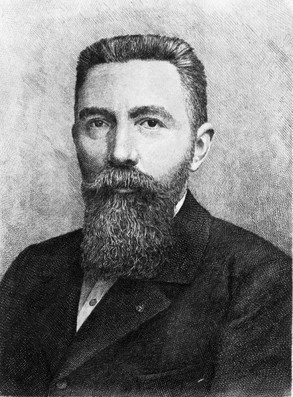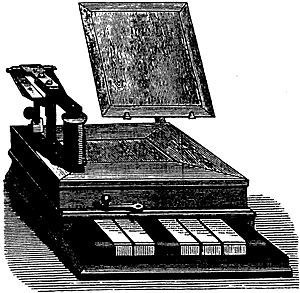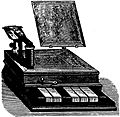Émile Baudot facts for kids
Quick facts for kids
Émile Baudot
|
|
|---|---|

Émile Baudot
|
|
| Born | 11 September 1845 Magneux, Haute-Marne, France
|
| Died | 28 March 1903 (aged 57) Sceaux, Hauts-de-Seine, France
|
| Nationality | French |
| Occupation | Engineer |
| Spouse(s) | Marie Josephine Adelaide Langrognet |
| Engineering career | |
| Projects | Baudot code |
| Significant advance | telecommunications |
| Awards |
|
Émile Baudot was a French engineer and inventor who lived from 1845 to 1903. He was a pioneer in telecommunications, which is how we send messages over long distances. Baudot invented the first way to send digital messages, called the Baudot code. He also created a special telegraph system that could send many messages at once over a single wire. The unit of speed for sending data, called the baud, is named after him.
Contents
Early Life and Education
Émile Baudot was born on September 11, 1845, in Magneux, France. His father, Pierre Emile Baudot, was a farmer who later became the mayor of their town. Émile only went to a local primary school. After school, he worked on his father's farm.
In 1869, he joined the French Post & Telegraph Administration. This was the government service that handled telegraph messages. They trained him to use the Morse code telegraph. He also learned about the Hughes printing telegraph system. This system later gave him ideas for his own inventions.
Baudot served briefly during the Franco-Prussian War. After the war, in 1872, he returned to his work in Paris.
Inventing the Telegraph System
The Telegraph Service encouraged Baudot to create a new system. They wanted a way to send several telegraph messages at the same time. This is called "time-multiplexing." Baudot realized that older telegraphs were often idle. They only sent messages for short moments.
Baudot found a way to use this idle time. He invented one of the first systems to send multiple messages at once. He used special clockwork switches that were synchronized. This meant they worked together perfectly at both ends of the telegraph line. With this system, he could send five messages at the same time. The French Post & Telegraph Administration officially adopted his system five years later.
The Baudot Code
Baudot invented his special telegraph code in 1870. He received a patent for it in 1874. This code used five bits, which are like tiny on/off signals. Each signal had equal on and off times. This allowed the telegraph to send the Latin alphabet, punctuation marks, and other control signals.
By 1874 or 1875, he had also perfected the machines needed to send his code. His inventions combined ideas from other inventors. He used the printing part from Hughes' machine and a distributor from Bernard Meyer. He also used the five-unit code idea from Carl Friedrich Gauss and Wilhelm Weber. Baudot added his own original ideas to create a complete system that could send many messages at once.
How the Baudot System Worked
On June 17, 1874, Baudot received a patent for his first printing telegraph. It was called "Système de télégraphie rapide." This system automatically turned signals into printed letters. Baudot's machine had three main parts: a keyboard, a distributor, and a paper tape.
Each operator, and there could be up to four, had their own section of the machine. The keyboard had only five piano-like keys. Operators used two fingers from their left hand and three from their right. The five-unit code was designed to be easy to remember.
Once the keys were pressed, they stayed down. They would only unlock when the machine was ready for the next character. An audible click, called the "cadence signal," warned the operator. Operators had to keep a steady rhythm. They usually sent messages at a speed of 30 words per minute.
The receiver machine was also connected to a distributor. Signals from the telegraph line were temporarily stored. Then, they were decoded to print the correct character onto paper tape. For the system to work well, the sending and receiving machines had to stay perfectly synchronized. Operators also had to send characters only when it was their turn.
First Uses of the System
The French Telegraph Administration accepted the Baudot system in 1875. The first tests happened between Paris and Bordeaux on November 12, 1877. By the end of 1877, a Baudot system was used on the Paris-Rome line, which was about 1,700 kilometers (1,056 miles) long. This system could send messages in both directions at the same time.
The Baudot machine was shown at the Paris Exposition Universelle (1878), a big world fair. He won the Exposition's gold medal. This helped his system become known around the world.
Later Career and Improvements
After his system became successful, Baudot was promoted to Controller in 1880. In 1882, he became an Inspector-Engineer.
In July 1887, he tested his system on the Atlantic telegraph cable. This cable connected Weston-super-Mare in England and Waterville, Nova Scotia, in Canada. The tests were successful, showing his system could work over long distances.
On August 8, 1890, he set up communication between Paris, Vannes, and Lorient using a single wire. On January 3, 1894, he installed a "triplex" machine between Paris and Bordeaux. This machine could send three messages at once. On April 27, 1894, he connected the Paris stock exchange and the Milan stock exchange with a single wire. He used his new invention, the retransmitter, for this.
In 1897, the Baudot system got even better. It started using punched tape. This tape was prepared offline, meaning operators could punch the messages before sending them. A tape reader, controlled by the Baudot distributor, then sent the messages. The tape had five rows of holes for the code. It also had a sixth row of smaller holes to move the tape through the reader. Baudot's code later became a standard called International Telegraph Alphabet Number One.
Baudot did not get much help from the French Telegraph Administration. He often had to pay for his own research. He even had to sell his gold medal from the 1878 Exposition Universelle in 1880.
The Baudot telegraph system was used more and more in France. Then, other countries started using it. Italy was the first, in 1887. The Netherlands followed in 1895, Switzerland in 1896, and Austria and Brazil in 1897. The British Post Office started using it in 1897 for a line between London and Paris. By 1913, many other countries, including Germany, Russia, Spain, and Argentina, had adopted it.
Final Years
Émile Baudot married Marie Josephine Adelaide Langrognet on January 15, 1890. Sadly, she died just three months later, on April 9, 1890.
Soon after he started working with the telegraph service, Baudot began to have health problems. He was often absent from work because of this. His condition affected him for the rest of his life. He died on March 28, 1903, in Sceaux, near Paris, at the age of 57.
Honors and Legacy
Émile Baudot received many awards for his inventions:
- 1881 - Diploma of Honor from the International Electrical Exposition.
- 1882 - Gold medal from the Société d'Encouragement pour l'Industrie Nationale (SEIN).
- 1889 - Ampere Medal from SEIN.
- 1878 - Knight's Cross of the Légion d'honneur.
- 1882 - Knight of the Order of Leopold (Belgium).
- 1884 - Knight of the Order of Franz Joseph of Austria.
- 1891 - Cross of the Order of the Crown of Italy.
- 1898 - Promoted to Officier of the Légion d'honneur.
- 1900 - Knight of the Order of Saints Maurice and Lazarus (Italy).
- 1901 - Knight of the Order of the Crown of Italy.
A street in Paris was named after Baudot, but it no longer exists. In 1926, a group called the International Telegraph Communications Advisory Committee met in Berlin. They honored Baudot by naming the baud after him. The baud is a unit that measures the speed of telegraph transmission.
In 1949, the French Post Office released a series of stamps with his portrait. By mistake, the year of his birth was printed as 1848 instead of 1845. The stamp was later corrected and reprinted in a different color. However, the stamps with the mistake are still collected by stamp enthusiasts and are worth more than the corrected ones.
Images for kids
See also
 In Spanish: Émile Baudot para niños
In Spanish: Émile Baudot para niños
- Baudot code




